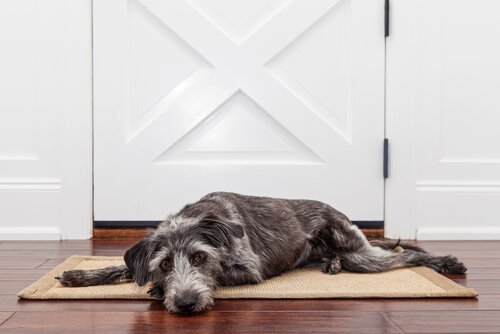How Long Can You Leave Your Dog Alone?


Written and verified by the lawyer Francisco María García
Unfortunately, it’s still not possible to take your dog wherever you want. Therefore, it’s important to make sure he is comfortable while you are away from home for a long time. Read this article to find out how long a dog can stay home alone without causing any negative effects on his health and behavior.
How long can a dog stay home alone?
First of all, there’s no one clear answer to this question. Every dog is unique and has its own needs. In general, veterinarians and dog trainers say the longest amount of time is around six or seven hours.
The time your dog can stay home alone depends on a lot of variables, such as age, state of health, and training. Puppies and elderly dogs are more vulnerable and need constant attention.
You must remember that every dog needs to learn how to manage being alone in a positive way, to avoid having behavioral problems. Training is a good way form this to happen.
The maximum time a dog can be left home alone is different from the time a dog can survive without his owner. Biologically, pets can survive for days without their owners. However, that doesn’t mean anyone should leave them home unattended for a long time because it greatly affects their physical and mental well-being.
Whenever you adopt a pet, you are responsible for giving him a good quality of life. You must consider if your lifestyle is truly compatible with the needs of a dog. There are other pets that require less time and simpler care, such as hamsters.

Can an adult dog stay home alone all day?
As mentioned above, it’s not good to leave dogs at home unattended for more than eight hours. When an owner is gone all day, a dog doesn’t really have a good quality of life. In addition to needing care, pets need to be around others to feel safe, happy, and comfortable at home.
Dogs are social creatures that need interaction to fully develop their emotional and cognitive abilities. Constant solitude is not good for them at all. If your dog stays home alone all day, he won’t be able to play with others and learn to socialize. Therefore, he might show signs of depression or other changes in his normal behavior.
In addition, dogs that spend a lot of time alone tend to have more sedentary lifestyles. An inactive routine ends up negatively affecting the pet’s physical and mental health. A lack of physical activity might cause weight gain and other health problems. For example, diabetes, cardiovascular issues, among others.
If dogs don’t have a healthy environment, their minds won’t be properly simulated. This can lead to the development of antisocial behavior, stress, and boredom. In severe cases, dogs might develop separation anxiety.

Advice for safely leaving your dog home alone
Obviously, everyone will have to leave their home for a little bit at some point. Working and fulfilling your responsibilities to provide a high quality of life for your family and pet is a must.
Here are some steps to help make sure the time your dog stays home alone won’t become a negative experience for him.
- Increase his daily physical activity: dogs need daily exercise to use up all of their energy, maintain a healthy weight, and remain psychologically stable. If your dog stays alone for hours on end, make sure to take a long walk before and afterwards.
- Give him a healthy environment: an interesting environment is essential when it comes to keeping your dog active and entertained while you’re gone.
- Pet shows usually have different kinds of games and toys to stimulate your dog’s body and mind. The Kong, for example, is a great option to give your dog an intellectual workout and fight symptoms of stress.
- Spend time with him: If you really must be gone for many hours every day, it’s important to set aside some quality time for your dog at home.
- After returning to the house, take your dog on a walk so that he gets some exercise and interacts with other dogs. It’s important to be affectionate and caring towards him to reinforce your bond with him.
Unfortunately, it’s still not possible to take your dog wherever you want. Therefore, it’s important to make sure he is comfortable while you are away from home for a long time. Read this article to find out how long a dog can stay home alone without causing any negative effects on his health and behavior.
How long can a dog stay home alone?
First of all, there’s no one clear answer to this question. Every dog is unique and has its own needs. In general, veterinarians and dog trainers say the longest amount of time is around six or seven hours.
The time your dog can stay home alone depends on a lot of variables, such as age, state of health, and training. Puppies and elderly dogs are more vulnerable and need constant attention.
You must remember that every dog needs to learn how to manage being alone in a positive way, to avoid having behavioral problems. Training is a good way form this to happen.
The maximum time a dog can be left home alone is different from the time a dog can survive without his owner. Biologically, pets can survive for days without their owners. However, that doesn’t mean anyone should leave them home unattended for a long time because it greatly affects their physical and mental well-being.
Whenever you adopt a pet, you are responsible for giving him a good quality of life. You must consider if your lifestyle is truly compatible with the needs of a dog. There are other pets that require less time and simpler care, such as hamsters.

Can an adult dog stay home alone all day?
As mentioned above, it’s not good to leave dogs at home unattended for more than eight hours. When an owner is gone all day, a dog doesn’t really have a good quality of life. In addition to needing care, pets need to be around others to feel safe, happy, and comfortable at home.
Dogs are social creatures that need interaction to fully develop their emotional and cognitive abilities. Constant solitude is not good for them at all. If your dog stays home alone all day, he won’t be able to play with others and learn to socialize. Therefore, he might show signs of depression or other changes in his normal behavior.
In addition, dogs that spend a lot of time alone tend to have more sedentary lifestyles. An inactive routine ends up negatively affecting the pet’s physical and mental health. A lack of physical activity might cause weight gain and other health problems. For example, diabetes, cardiovascular issues, among others.
If dogs don’t have a healthy environment, their minds won’t be properly simulated. This can lead to the development of antisocial behavior, stress, and boredom. In severe cases, dogs might develop separation anxiety.

Advice for safely leaving your dog home alone
Obviously, everyone will have to leave their home for a little bit at some point. Working and fulfilling your responsibilities to provide a high quality of life for your family and pet is a must.
Here are some steps to help make sure the time your dog stays home alone won’t become a negative experience for him.
- Increase his daily physical activity: dogs need daily exercise to use up all of their energy, maintain a healthy weight, and remain psychologically stable. If your dog stays alone for hours on end, make sure to take a long walk before and afterwards.
- Give him a healthy environment: an interesting environment is essential when it comes to keeping your dog active and entertained while you’re gone.
- Pet shows usually have different kinds of games and toys to stimulate your dog’s body and mind. The Kong, for example, is a great option to give your dog an intellectual workout and fight symptoms of stress.
- Spend time with him: If you really must be gone for many hours every day, it’s important to set aside some quality time for your dog at home.
- After returning to the house, take your dog on a walk so that he gets some exercise and interacts with other dogs. It’s important to be affectionate and caring towards him to reinforce your bond with him.
This text is provided for informational purposes only and does not replace consultation with a professional. If in doubt, consult your specialist.







